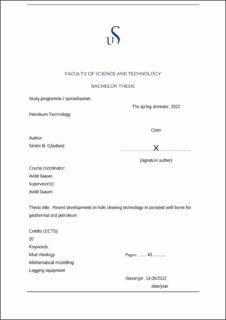| dc.description.abstract | This paper is looking on recent developments in hole cleaning technologies and how recent advancements can be used to aid efficient hole cleaning in deviated wells. Successful hole cleaning relies upon integrating optimum drilling fluid properties with the best drilling practices. The ability of the drilling fluid to transport the drilling cuttings to the are determined by several parameters (cutting density, mud weight, hole-size, hole-angle, rheology of fluid, cutting size, rate of penetration, drill pipe eccentricity, drill pipe rotation speed, phase of fluid, cutting transport ratio and cutting bed properties).
Efficient hole cleaning of deviated wells is important and difficult to perform efficiently, deviated wells normally uses drilling fluid with lower viscosity and gel building properties than in vertical section. Deviated wells are an important tool to either boost the return from existing fields or gaining access to new and formerly inaccessible formations. The increasing need for oil and gas have kept increasing with ever increasing energy output in the world, despite the world trying to swap to more renewable resources. Petroleum products such as coal, gas and oil still stand for over 80% of the energy production in the world. Increasing energy demands from the world exceeds the development within renewable technologies and gaining access to new formation and extracting most of the oil and gas in current formation will be paramount in giving people access to energy required to keep the world running. Percentage of world’s energy coming from renewable resources has increased and will hopefully keep increasing, but total energy demand especially from developing countries with increasing population and higher standard of living requires higher amount of energy than the countries are currently consuming with renewable being too expensive, inefficient, or lacking the required infrastructure for implementation. The paper is a compilation of recent developments and would hopefully give the reader insight in the processes most important efficient hole cleaning for deviated wells.
The topic of efficient hole cleaning is complex, and a lot of different parameters will be introduced to understand the role of new developments. Basic understanding of these parameters and their interplay with each other is required to understand to keep the innovation with respect to efficient hole cleaning and automating more of the process involved in hole cleaning while drilling in deviated wells.
The paper also uses the information from collected studies to write to a data code based on recent developments to aid in controlling the right rate of penetration (ROP) during drilling. No independent research was those in this paper and is based on the work of research and literature of others. | |
